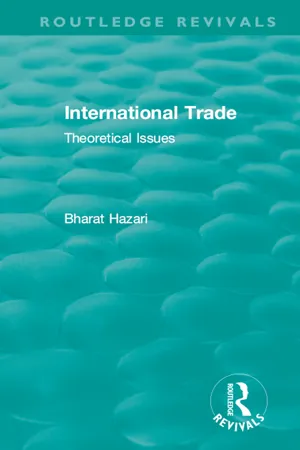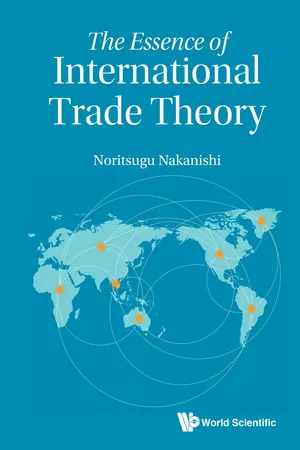Economics
Specific Factors Model
The Specific Factors Model is an economic theory that examines the effects of changes in production factors on the distribution of income. It assumes that factors of production, such as labor and capital, are specific to certain industries and cannot be easily reallocated. This model helps to explain the impact of trade and technological changes on income distribution within an economy.
Written by Perlego with AI-assistance
Related key terms
4 Key excerpts on "Specific Factors Model"
- eBook - ePub
Routledge Revivals: International Trade (1986)
Theoretical Issues
- Bharat Hazari(Author)
- 2018(Publication Date)
- Routledge(Publisher)
Before proceeding to present the Jones model it is important to spell out the rationale behind sector specificity of factors of production. There exist at least three different types of sector specificity. First, there is preferential specificity — a case in which the factor prefers to be employed in one sector rather than the other. For example, labour working on the night shift may demand a premium for night work. Preferential specificity may generate a model of wage differentials. Such a model was first presented by Lancaster (1958) and later explored among others by Manning and Sgro (1975). Second, factors may be specific in the aptitudinal sense — thus a factor of production may have comparative advantage in producing one commodity rather than the other. Note that when a factor of production has an infinite preference for working in a sector the system reduces to the pure Jones model. The third type of factor specificity is policy-imposed. For example, a metropolitan country may not necessarily allow foreign factors to be employed in all sectors of the economy and may impose restrictions on their mobility. A similar situation could arise when a Third-World government, for various non-economic objectives, might not allow foreign factors to be employed in all sectors of the economy. In fact, due to government regulations the foreign factors of production may be employed as specific factors of production.15.1 The Jones Model with Sector SpecificityWe now proceed to present the Jones model. This model may be viewed as an extension of the Ricardian system of comparative advantage where each sector has a fixed and non-transferable quantity of a specific factor, for example, capital K1 , and capital K2 .2 Both sectors use one mobile factor, labour. Let us suppose that commodity X1 is produced with a fixed quantity of capital K1 and commodity X2 with a fixed quantity of capital K2 and labour.The above system can be represented in terms of a box diagram which can also be used to generate the production possibility locus. In Figure 15.1 the horizontal distance represents the total endowment of the mobile factor labour. The vertical distance represents the magnitude of capital which is used by sector 1 only. Therefore, all solutions with full utilization of capital for sector 1 must be on the horizontal line . Sector 2 is represented from the origin O2 . This sector has a fixed supply of sector-specific capital. Therefore, given the assumption of full utilization of capital in sector 2 the solutions for this sector must also be on the line . Hence, the contract curve in the specific-factor case becomes instead of O1 EO2 in the non-specific-factor case. Two features should be noted. First, there is only one point which is common to both the production possibility curves, namely the non-specific and specific-factor cases. This is shown in Figure 15.2 by point P. Second, only the real wage will be equalized between the sectors (because labour is fully mobile). The return to the specific factor would generally be different across the sectors, as is shown by point E′ in Figure 15.1 . Only in the limiting case would the factor prices across sectors be equalized — as shown by point E. Since E′ is off the normal contract curve and is characterized by inequality in the marginal rates of substitution between sectors the production possibility curve of the sector-specific case must be dominated by the production possibility curve of the non-specific case, as is shown in Figure 15.2 . Note that except at point E - eBook - ePub
Global Trade Policy
Questions and Answers
- Pamela J. Smith(Author)
- 2013(Publication Date)
- Wiley-Blackwell(Publisher)
This chapter explored inter-industry, inter-firm trade. This trade is two-way trade in dissimilar goods between the national firms of countries. We examined this trade using three traditional trade models: the Ricardian model, the Heckscher-Ohlin model, and the Specific Factors Model. These three models are grounded on the concept of comparative advantage. The law of comparative advantage says that countries will produce and export goods that have a lower relative cost, and therefore price, in autarky. In the Ricardian model, this comparative advantage arises from differences in technologies across countries. In the Heckscher-Ohlin model, comparative advantage arises from differences in endowments across countries. And, in the Specific Factors Model, comparative advantage arises from differences in immobile endowments across countries. The Ricardian and Heckscher-Ohlin models are long-term models because they allow factors of production to move freely across industries. The Specific Factors Model is a short-term model because it accounts for the immobility of factors of production across industries. Below, we summarize the key findings from each of these models.What are the effects of trade in the long run, when countries differ in technologies? We used the Ricardian model to examine the effects of trade in the long run, when countries differ in technologies. When countries differ in technologies, the production possibilities of countries are biased toward the industries with relatively high productivities. These industries have relatively low costs and prices in autarky. When we allow for trade, countries export the goods that have relatively low autarky costs/prices and import the goods that have relatively high autarky costs/prices. That is, countries export goods with relatively high productivities and import goods with relatively low productivities. This trade occurs at world prices that are advantageous relative to domestic autarky prices. That is, trade occurs at world prices where the price of exports relative to imports is high in comparison to autarky. As countries specialize in their sectors of comparative advantage and trade, their joint output increases. This pattern of production and trade results in gains. These gains appear as an increase in countries' consumption possibilities and utility (or well-being).What are the effects of trade in the long run, when countries differ in endowments? - eBook - ePub
- W. Charles Sawyer, Richard L. Sprinkle(Authors)
- 2020(Publication Date)
- Routledge(Publisher)
mobile factor because over time it can move between machine production and cloth production. Remember, when trade opens up between the U.S. and India, the machine industry expands and the cloth industry contracts in the U.S. Initially, if all factors of production are immobile, as the cloth industry contracts, both capital and labor in this industry suffer losses as employment contracts and factories are shut down. In the expanding machine industry, both labor and capital benefit as employment and profits increase. In fact, these initial industry-specific effects often dominate the political debate over trade policy within a country.Now, suppose that labor can move between industries and capital is immobile. Point E in Figure 4.1 illustrates the before-trade equilibrium for the U.S. In the figure, the total supply ofWith the specific-factors model, as the demand for labor in the machine industry increases the wage rate rises and workers move from the cloth industry to the machine industry.FIGURE 4.1Specific-factors modellabor is shown along the horizontal axis. The amount of labor employed in the machine industry is measured from O rightward along the axis, and the amount of labor employed in the cloth industry is measured from O¢ leftward along the axis. In each industry, labor is combined with a fixed amount of specific capital to produce either cloth or machines. Under these conditions, labor is subject to diminishing returns in each industry. This means that the demand for labor in each industry is downward sloping and is equal to the value of the marginal product of labor.14 The machine industry’s demand for labor is represented by DM , and the cloth industry’s demand for labor is represented by DC . (The cloth industry’s demand for labor is measured leftward from O¢.) By assuming that labor is mobile between industries, both the machine industry and the cloth industry will pay the same wage rate, W0 - eBook - ePub
- Noritsugu Nakanishi(Author)
- 2018(Publication Date)
- WSPC(Publisher)
income distribution within a country.3.1The Roles of General Factors
Let us begin with the simplest HOS model with two countries (A and B), two goods (1 and 2), and two factors of production called capital and labor.1 Both capital and labor are general factors in the sense that they are used in the production of both goods and freely mobile across industries. We assume that both countries share the same production technologies, but the (ratio of) factor endowments of them are different. For the moment, we concentrate on the situation in one country and omit the indices that stand for “countries” from the notation.3.1.1Technology
Let Kj≥ 0 and Lj≥ 0 be the inputs of capital and labor for the production of good j = 1, 2, respectively. Production technology of good j is described by a neoclassical production function Fj(Kj, Lj), which is differentiable, monotonically increasing, linearly homogeneous, and concave in (Kj, Lj).Production possibility set: Let K > 0 and L > 0 be the endowments of capital and labor of a country, respectively. Total amounts of capital and labor used in the production of both goods must satisfy the resource constraints: K1 + K2 ≤ K and L1 + L2 ≤ L. Production vector is denoted by y = (y1 , y2 ). Then, the production possibility set (PPS) is defined as follows:Fig. 3.1 Production Box Diagramwhich is a compact convex subset of R + 2 . As shown in Chapter 1 , a factor allocation, {(K1 , L1 ), (K2 , L2
Index pages curate the most relevant extracts from our library of academic textbooks. They’ve been created using an in-house natural language model (NLM), each adding context and meaning to key research topics.



